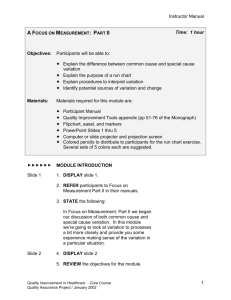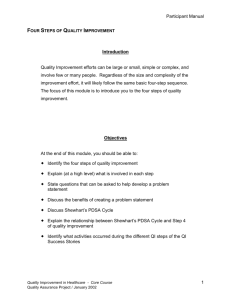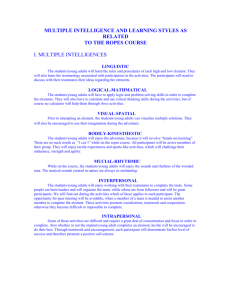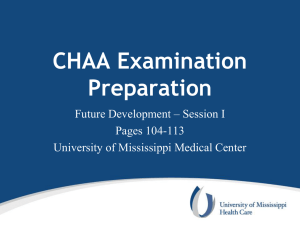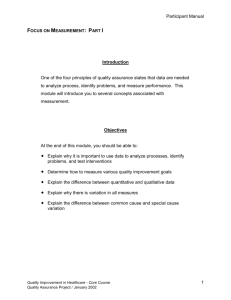Introduction to Quality Improvement
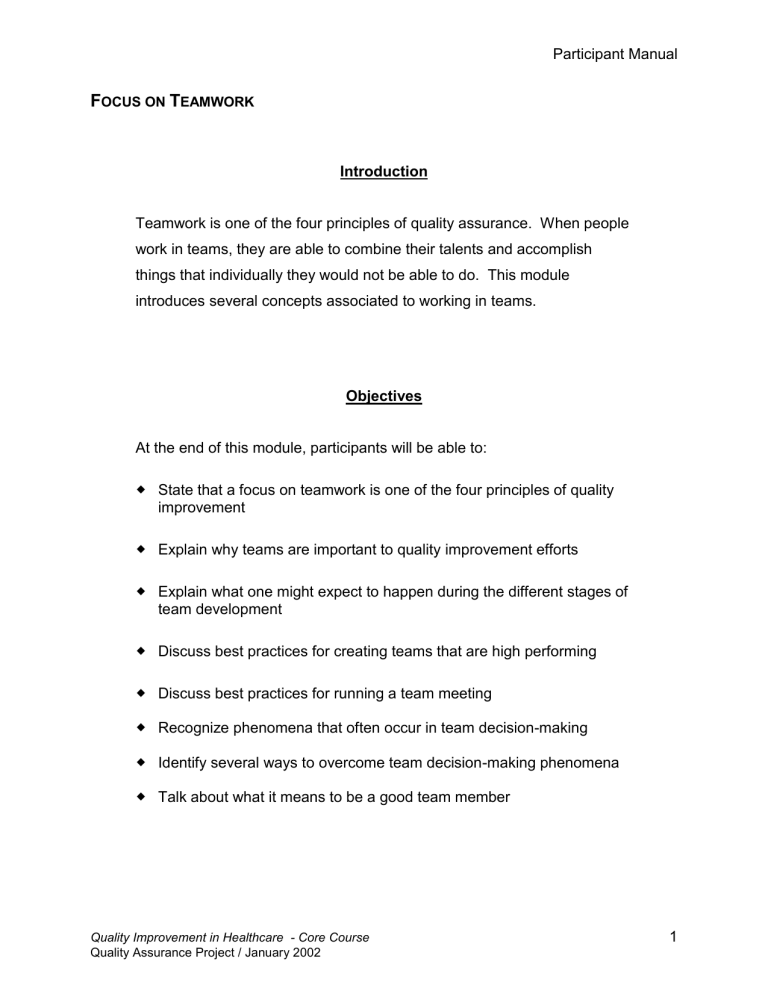
Participant Manual
F
OCUS ON
T
EAMWORK
Introduction
Teamwork is one of the four principles of quality assurance. When people work in teams, they are able to combine their talents and accomplish things that individually they would not be able to do. This module introduces several concepts associated to working in teams.
Objectives
At the end of this module, participants will be able to:
State that a focus on teamwork is one of the four principles of quality improvement
Explain why teams are important to quality improvement efforts
Explain what one might expect to happen during the different stages of team development
Discuss best practices for creating teams that are high performing
Discuss best practices for running a team meeting
Recognize phenomena that often occur in team decision-making
Identify several ways to overcome team decision-making phenomena
Talk about what it means to be a good team member
1 Quality Improvement in Healthcare - Core Course
Quality Assurance Project / January 2002
Participant Manual
Focus on Teamwork
Teamwork is one of the four principles of quality improvement. Other principles include client focus, understanding work as processes and systems, and testing changes and emphasizing the use of data. The four principles of quality improvement were introduced in the Introduction to Quality Improvement. Each is briefly described in the table below.
The Four Principles of Quality Assurance
Client Focus
Services should be designed so as to meet the needs and expectations of clients and community.
Understanding Work as Processes and Systems
Providers must understand the service system and its key service processes in order to improve them.
Testing Changes and Emphasizing the Use of Data
Changes are tested in order to determine whether they yield the required improvement. Data are used to analyze processes, identify problems, and to determine whether the changes have resulted in improvement.
Teamwork
Improvement is achieved through the team approach to problem solving and quality improvement.
2 Quality Improvement in Healthcare - Core Course
Quality Assurance Project / January 2002
Participant Manual
The Value of Teams
Teams are important in process improvement efforts several reasons.
While an individual might have knowledge gaps about a process, a group of people will likely have a more complete understanding. Each person in a team can share their understanding and perspective, building a complete picture of the process.
Mutual support and cooperation is often created when people work together on a project. This feeling of good will often leads to an increased commitment to make improvements.
Team accomplishments often lead to increased confidence among individuals.
Competence and confidence create an upward spiral where competence builds confidence and confidence builds competence.
A proposed solution will meet with much less resistance if the people who will be impacted by the change have contributed to the development of the solution.
Quality Improvement in Healthcare - Core Course
Quality Assurance Project / January 2002
3
Participant Manual
Stages of Team Development
Decades of research in teams and work groups show that there are five stages of team development. The five stages have been labeled forming, storming, norming, performing, and closing. It is generally believed that groups become more effective as they proceed through the stages, and are most effective when they reach stage four — performing. Team development is not always one way
—different situations may cause the team to return to an earlier stage. This might include the addition of a new member, a change in leadership, or the introduction of a new task for the team. Each of the stages is briefly described below.
1. Forming . During the forming stage, a great deal of uncertainty exists about the purpose, structure and leadership of the team. Members experiment to determine what types of behavior is acceptable. This stage is complete when members begin to think of themselves as part of the team.
2. Storming . During the storming stage there is a great deal of conflict within the team. Members accept the group’s existence, but there is resistance to the constraints on individuality that result as a function of team membership. Conflict also develops over who will control the team. This stage is complete when there is a relatively clear hierarchy of leadership within the group.
3. Norming.
During the norming stage, close relationships develop and the team demonstrates cohesiveness. The team develops an identity and members enjoy camaraderie with one another. This stage is complete when the group structure becomes established and the team develops a shared understanding of how a team member should behave.
4. Performing.
During the performing stage the tram structure is in place and accepted. The team focus has changed from establishing group norms to performing the task at hand. It is during this stage that the team performs at its best.
5. Closing . During the closing stage, teams that are not permanent work groups prepare to disband. Some team members will enjoy the feeling of accomplishment, while others will begin to mourn the loss of camaraderie gained during the life of the team.
4 Quality Improvement in Healthcare - Core Course
Quality Assurance Project / January 2002
Participant Manual
Best Practices for Creating High Performing Teams
Building a team that functions well requires hard work a nd commitment. In “The
Wisdom of Teams”, authors Katzenbach and Smith 1 recommend eight important practices in the creation of high performing teams. They are:
1. Establish urgency and direction.
All members need to believe that the team has an urgent and worthwhile purpose. Furthermore, they need to know the expectations for the team.
2. Select members based on skills and skill potential, not personalities.
Teams need complementary skills to perform well. Three categories of skills are required:
1) technical and functional, 2) problem-solving, and 3) interpersonal. When you can’t select members with the necessary skills, it will be important to develop them.
3. Pay particular attention to first meetings and actions.
Recognize that first impressions mean a lot. During a team’s first meeting, participants will monitor the signals given by others to confirm, or dispel assumptions that they might have. In particular, people will want to understand who will have the greatest influence on the team and if they will play an important role.
4. Set some clear rules for behavior. It’s important to set rules to promote focus, commitment, openness, and trust among team members. Some important rules pertain to attendance, discussion, confidentiality, constructive feedback, and contributions.
5. Set and seize upon a few immediate achievable goals.
In order to gain momentum, it’s important to establish a few challenging yet achievable goals that the team can achieve early during its lifecycle. Once it has achieved success once, it will find it easier to achieve again.
6. Challenge the group regularly with new facts and information.
New information encourages the team to redefine its understanding of the quality improvement opportunity. This leads to a clearer understanding of its purpose and goals.
7. Spend lots of time together.
In order to become high performing, teams must spend time together, especially at the beginning. The time spent together should be planned and unplanned, formal and informal. Meetings should be held every 2 to 4 weeks to keep the initiative moving ahead.
8. Exploit the power of positive feedback, recognition, and reward.
Provide positive reinforcement to shape the behaviors that you want team members to exhibit. Positive reinforcement can take many forms and be public or private.
Possibilities include a day off, or a certificate of commendation for a job well done.
1 Katzenbach and Smith, “The Wisdom of Teams,” McKinsey and Company, Inc., 1994
5 Quality Improvement in Healthcare - Core Course
Quality Assurance Project / January 2002
Participant Manual
Whatever mechanism is used, it must be one that is valued by the recipient and culture.
9.
Conducting a Team Meeting
One way to improve the productivity of teams is to run productive team meetings. Here are 10 tips that should be followed to make a meeting more effective and efficient.
1. Prepare a meeting agenda . An agenda serves to define the purpose of the meeting. It should include: who will attend the meeting, what, if any, preparation is required of each participant, a listing of items to be covered, meeting start and ending times, and the meeting location.
2. Distribute the agenda in advance . Distribute the agenda at least a three days before the meeting to allow participants to prepare for it. Allow more time if there is a substantial amount of preparation required.
3. Confirm participants responsible for agenda items . At least one or two days before the meeting, contact individuals who have responsibility for various agenda items to ensure they will be prepared.
4. Encourage participants to review the agenda . At the start of the meeting, review the agenda, make any adjustments that might be required, and set time parameters for each agenda item.
5. Establish and maintain specific time parameters.
Use good time management procedures to ensure the meeting begins and ends on time. Manage the time devoted to each agenda item to ensure each agenda item is discussed.
6. Maintain focused discussion.
Where necessary, manage interruptions in irrelevant comments to keep discussion focused on the issues. Ensure assignments are made for work to be accomplished before the next meeting.
7. Encourage and support participation of all members . Monitor the discussion during meetings to ensure everyone has the ability to contribute. Use nonthreatening techniques to draw out quiet or reserved participants and curtail those who might monopolize the discussion. Make sure task and responsibilities are distributed among all members to avoid undue burden on some.
8. Encourage the clash of ideas . Encourage people to share their points of view, critical thinking, and constructive disagreements.
9. Discourage the clash of personalities.
Don’t allow personal attacks or other insults.
6 Quality Improvement in Healthcare - Core Course
Quality Assurance Project / January 2002
Participant Manual
10. Bring proper closure.
Close a meeting by summarizing the group’s decisions and accomplishments, assigning follow-up assignments, scheduling the next meeting, and preparing its agenda.
Quality Improvement in Healthcare - Core Course
Quality Assurance Project / January 2002
7
Participant Manual
Team Decision Making Phenomena
There are several phenomena that influence decision making in groups. One of the most common is known as groupthink.
Groupthink
Groupthink is a common team phenomenon. Because group members develop a sense of camaraderie, there is a strong desire to conform. This desire to conform overrides the realistic analysis of alternative options and the expression by team members of what might be minority or unpopular views. Some symptoms of groupthink include:
Members hold onto initial assumptions that were made by the group no matter how strong the evidence might be to contradict it
Members do not question a leader’s direction or conclusion, even when it would be appropriate or correct to do so – they adopt a “yes, boss” mentality
Members apply pressure to those who might express doubts about the group’s shared view or who question the alternative favored by the majority
Members who have doubts or differing points of view avoid deviating from what appears to be the group consensus by keeping silent about misgivings and even minimizing to themselves the importance of their doubts
There appears to be an illusion of unanimity. If someone doesn’t speak against an idea the group assumes that he or she is in agreement
Breaking a complex problem into simple parts
When dealing with a complex problem it is common to want to reduce the problem into parts that are more easily understood. This is because it takes much more mental effort to assimilate all of the information necessary to understand the problem in full. A downside of this phenomenon is that breaking a problem into smaller parts may lead to solving only that part of the problem, not the entire problem.
1
Good enough is good enough
When considering solutions to a problem, decision makers may face a large number of choices. They may review them only until they identify a choice that is satisfactory rather than considering all the alternatives. This differs from finding the “optimum” solution, but may be “good enough” to serve their needs.
1 Fobbins, S.P. (1998). Organizational Behavior, 8 th ed. Upper Saddle River, NJ: Prentice-Hall, Inc.
Quality Improvement in Healthcare - Core Course
Quality Assurance Project / January 2002
8
Participant Manual
Exercise: Overcoming Team Decision Making Phenomena
Directions: In a large group setting, conduct a force field analysis of strategies that could be used to help overcome group decision-making phenomena such as group think. Use the space provided below to copy the diagram created by the class.
Quality Improvement in Healthcare - Core Course
Quality Assurance Project / January 2002
9
Participant Manual
Exercise: Characteristics of Good Team Members
Directions: On an individual basis, read each of the team member characteristics listed below. Select ten that best describe what it takes to be a good team member (there are no right answers). Once you’ve selected the ten most important characteristics, form groups of 3 to 4 people and discuss your selections. Reach a consensus of the ten most important characteristics and report your ideas to the class.
Characteristics of Good Team Members 2
Makes decisions quickly Is willing to take chances
Accepts criticism
Delegates well
Foresees problems
Is people oriented
Is creative
Avoids cliques
Has good judgment
Is assertive
Cares about people
Has high personal goals
Is punctual
Is an idealist
Is good at synthesizing ideas
Is self motivated
Is a good planner
Is goal oriented
Thanks people often
Socializes
Is firm
Is modest
Is able to influence others
Is task oriented
Seeks ideas from others
Has good self-control
Is a good listener
Is a realist
Is friendly
Lets others offer solutions
Is considerate of others
Is self-confident
2 Adapted from WARMUPS FOR MEETING LEADERS. Sue Bianchi, Jan Butler, and David Richey. San
Diego, California: University Associates, 1990.
10 Quality Improvement in Healthcare - Core Course
Quality Assurance Project / January 2002
